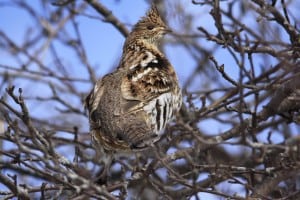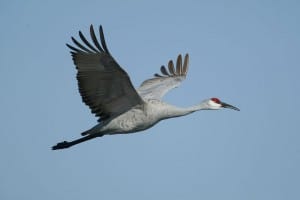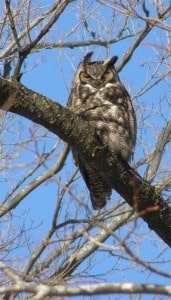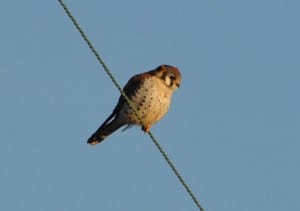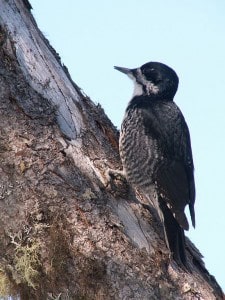The annual Christmas Bird Count reveals the ups and downs of bird populations – and always some surprises.
Between mid-December and early January, birders in more than 2,500 localities across North, Central and South America take a break from the holiday festivities to spend a day outside, identifying and counting birds. Dating all the way back to 1900, the Christmas Bird Count is probably the longest-running Citizen Science project in the world. The information collected by thousands of volunteer participants forms one of the world’s largest sets of wildlife survey data.
One of the most interesting trends the numbers show is the decades-long northward march of the Mourning Dove, Red-bellied Woodpecker, Carolina Wren, Northern Mockingbird, Tufted Titmouse and Northern Cardinal. Mourning Doves, for example, were extremely rare in the northern states and Canada until the 1960s, and it was only in the 1970s that their numbers really increased. All of these species used to be restricted to the southern U.S. Their range extension northward is most likely the result of a combination of milder winters and more people feeding birds.
The counts are organized at the local level, often by a birding club or naturalist organization. The count area is a circle, measuring 24 kilometres in diameter. The circle is then sub-divided into sectors, each of which is covered by a different group of birders. The basic idea is to identify and count – as accurately as possible – every bird seen or heard.
Once again this year, two local counts were held – one centred in Peterborough and the other in Petroglyphs Provincial Park. The Petroglyphs Count circle can be viewed at bit.ly/2EfuPt8. Martin Parker of the Peterborough Field Naturalists organized the Peterborough count, while Colin Jones was in charge of the Petroglyphs count.
Peterborough Count
The 66th Peterborough Christmas Bird Count was held December 17 under cold but sunny conditions. Seventy-one members and friends of the Peterborough Field Naturalists spent all or part of the day in the field, while 10 others kept track of birds visiting their feeders.
By the end of the day, participants had found 13,166 individual birds of 60 species. A pair of Fox Sparrows and a Sandhill Crane were new to the count. Both of these migratory species should have left the Kawarthas well before mid-December. At the compilation dinner after the count, Scott McKinlay described his group found and identified the crane. “I saw this bird through my scope from a considerable distance – maybe a kilometre – as it flew low over an open field in full sunlight. It had broad wings and the slow, arching wing beats typical of large herons and cranes. It was clearly brown in colour. I was reluctant to call it as a Sandhill because of the distance and time of year, but nothing else fit. A short time later, I reunited with the rest of the group, who had been surveying the area in the direction of my sighting. Before I uttered a word, they yelled out, “I think we saw a Sandhill Crane!” They described it as being the size of a Great Blue Heron with an outstretched neck, long trailing legs and flying low over a field in my direction. All three were adamant, however, that it was not a heron.”
Record high numbers were tallied on the count for Cooper’s Hawk (12), Bald Eagle (13), Red-bellied Woodpecker (16), Pileated Woodpecker (28), Dark-eyed Junco (731) and Northern Cardinal (144). Previous highs were tied for Merlin (3) and Peregrine Falcon (1). The 466 Blue Jays tallied was three short of the previous high of 469.
There were also some notable low numbers. As has been the pattern in recent years, Great Horned Owls (2 vs. 40 in 1992), Ruffed Grouse (17 vs. 82 in 1979) and House Sparrows (181 vs. 2209 in 1981) were conspicuous by their relative absence. It is well known fact that Ruffed Grouse numbers fluctuate a great deal from year to year and even decade to decade. However, the factors responsible for these periodic fluctuations remain poorly understood. Road mortality and changes in habitat, especially south of the Canadian Shield, probably play a role, as well. These include forest fragmentation and fewer early-successional, aspen-dominated forest blocks. Ruffed Grouse are only capable of relatively short flights.
The decline of Great Horned Owls is another mystery. The Canadian population has dropped by over 70% since the 1960s. Collisions with vehicles and high mortality of fledged young due to starvation are acknowledged as playing an important roles. Declines in principal prey species, such as cottontails, hares and rodents (e.g., a big drop in muskrat numbers) may be a contributing factor.
The downturn in House Sparrow populations, however, may be the biggest enigma. This is evident across the bird’s range, which includes every continent except Antarctica. The cause or causes are not yet known. In rural areas, it may be that changes in agricultural practices have resulted in fewer nesting sites and less food availability. In northeastern North America, it also been postulated that competition with a relatively new arrival, the House Finch, is a playing a role. However, House Finches have also been declining for a number of years. Only 181 were found this year, which is about one tenth of the record high of 1197.
Finally, not a single American Kestrel was found on the count. It is estimated that the continent-wide population of this small falcon has declined by about 50% since 1966. Part of the reason may be the felling of standing dead trees on which they depend for nesting sites. Removing hedgerows and brush as part of “clean” farming practices are almost certainly having an effect, too. According to Don Sutherland of the Natural Heritage Information Centre in Peterborough, American Kestrels are still common in parts of northern Ontario, particularly in the Big and Little Clay Belts where agriculture is less intense and there is an abundance of hayfields and pasture.
The total tally sheet for the Peterborough count is as follows: Canada Goose 400, American Black Duck 8, Mallard 964, Bufflehead 2, Common Goldeneye 100, Hooded Merganser 1, Common Merganser 7, Ruffed Grouse 17, Wild Turkey 223, Sharp-shinned Hawk 2, Cooper’s Hawk 12, Bald Eagle 13, Red-tailed Hawk 49, Sandhill Crane 1, Ring-billed Gull 9, Herring Gull 121, Glaucous Gull 1, Iceland Gull 1, Great Black-backed Gull 1, Rock Pigeon 1680, Mourning Dove 1088, Eastern Screech-Owl 2, Great Horned Owl 2, Snowy Owl 1, Belted Kingfisher 1, Red-bellied Woodpecker 16, Downy Woodpecker 90, Hairy Woodpecker 62, Northern Flicker 1, Pileated Woodpecker 28, Merlin 3, Peregrine 1, Northern Shrike 8, Blue Jay 466, American Crow 612, Common Raven 9, Black-capped Chickadee 2065, Red-breasted Nuthatch 27, White-breasted Nuthatch 88, Brown Creeper 7, Golden-crowned Kinglet 28, American Robin 181, European Starling 2227, Cedar Waxwing 115, Snow Bunting 143, American Tree Sparrow 439, Dark-eyed Junco 731, Fox Sparrow 2, Song Sparrow 1, White-throated Sparrow 5, Northern Cardinal 144, Red-winged Blackbird 2, Brown-headed Cowbird 1, House Finch 181, Purple Finch 2, White-winged Crossbill 1, Pine Siskin 99, American Goldfinch 424 and House Sparrow 181. A Northern Harrier, Ring-necked Pheasant and Carolina Wren were also seen during the count period but not on the day of the count.
Petroglyph Count
The 32nd Petroglyph Christmas Bird Count took place on December 27, in frigid weather conditions. The 24 participants braved temperatures of close to -30 C in the early morning and only -18 by mid-afternoon. Despite the weather, 32 species and 1826 individual birds were tallied, which is close to the 10-year average of 33.5 species and 2,248 individuals. There was virtually no open water, however, and therefore no waterbirds.
Although no new species were recorded or records broken, there were some notable results. An above-average 7 Bald Eagles, 146 Red-breasted Nuthatches, 122 American Tree Sparrows and 134 Dark-eyed Juncos were counted. A Gray Jay was also located in a bog along the Sandy Lake Road south of Lasswade. Up until 2009, this species was recorded annually but since then only observed in 2014 and during the week of the count in 2016. Two other birds of note were an immature Golden Eagle seen soaring over the Kawartha Nordic Ski Trails near Haultain and a Black-backed Woodpecker in Petroglyphs Provincial Park.
As for winter finches, 41 Red Crossbills and 8 White-winged Crossbills turned up, some of which were singing! These birds will nest in any month of the year if sufficient food is available. This year, nearly all of our conifers produced a bumper seed crop. Crossbills feed almost exclusively on conifer seeds. Two Purple Finch, 114 Pine Siskin, 103 American Goldfinch and 2 Evening Grosbeak rounded out the finch count.
The total tally sheet for the Petroglyph count is as follows: Ruffed Grouse 7, Wild Turkey 40, Bald Eagle 7, Red-tailed Hawk 2, Golden Eagle 1, Rock Pigeon 10, Mourning Dove 9, Barred Owl 1, Downy Woodpecker 25, Hairy Woodpecker 39, Black-backed Woodpecker 1, Pileated Woodpecker 11, Gray Jay 1, Blue Jay 206, American Crow 4, Common Raven 42, Black-capped Chickadee 641, Red-breasted Nuthatch 146, White-breasted Nuthatch 40, Brown Creeper 17, Golden-crowned Kinglet 32, American Robin 2, European Starling 10, Cedar Waxwing 6, American Tree Sparrow 122, Dark-eyed Junco 134, Purple Finch 2, Red Crossbill 41, White-winged Crossbill 8, Pine Siskin 114, American Goldfinch 103, and Evening Grosbeak 2.
Backyard Count
If you are inspired by the Christmas Bird Count and want to contribute to Citizen Science yourself – and maybe introduce your children or grandchildren to birding – consider taking part in the Great Backyard Bird Count. It takes place February 16-19 and anyone can participate. Simply tally the numbers and kinds of birds you see for at least 15 minutes on one or more days of the count. You can do so from any location. Go to gbbc.birdcount.org for details. To see the results of last year’s count, visit gbbc.birdcount.org/2017-gbbc-summary/
